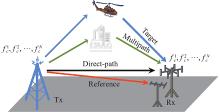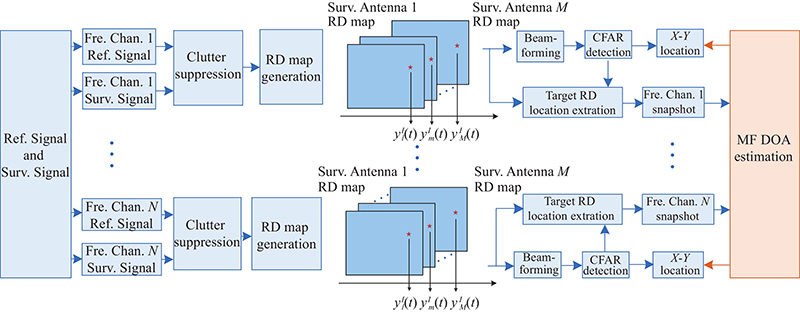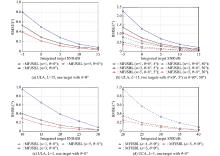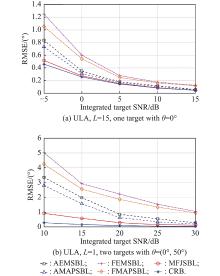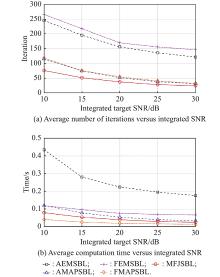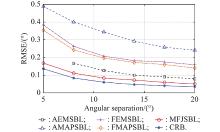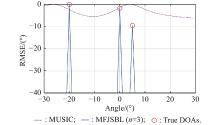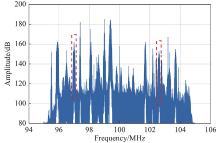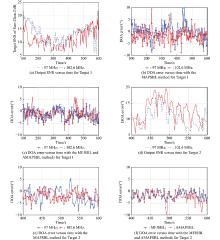| 1 |
GRIFFITHS H D, BAKER C J. An introduction to passive radar. Norwood: Artech House, 2017.
|
| 2 |
KUSCHEL H, CRISTALLINI D, OLSEN K E Tutorial: passive radar tutorial. IEEE Aerospace and Electronic Systems Magazine, 2019, 34 (2): 2- 19.
|
| 3 |
WAN X R, YI J X, ZHAN W J, et al Research progress and development trend of the multi-illuminator-based passive radar. Journal of Radars, 2020, 9 (6): 939- 958.
|
| 4 |
COLONE F, BONGIOANNI C, LOMBATDO P Multifrequency integration in FM radio-based passive bistatic radarPart II: direction of arrival estimation. IEEE Aerospace and Electronic Systems Magazine, 2013, 28 (4): 40- 47.
doi: 10.1109/MAES.2013.6506828
|
| 5 |
FILIPPINI F, MARTELLI T, COLONE F, et al Target DOA estimation in passive radar using non-uniform linear arrays and multiple frequency channels. Proc. of the IEEE Radar Conference, 2018, 1290- 1295.
|
| 6 |
GEUN-HO P, DONG-GYU K, JAE K H, et al Maximum-likelihood angle estimator for multi-channel FM-radio-based passive coherent location. IET Radar, Sonar and Navigation, 2018, 12 (6): 617- 625.
doi: 10.1049/iet-rsn.2017.0419
|
| 7 |
SU G N, MORF M The signal subspace approach for multiple wide-band emitter location. IEEE Trans. on Acoustics, Speech and Signal Processing, 1983, 31 (6): 1502- 1522.
doi: 10.1109/TASSP.1983.1164233
|
| 8 |
WANG H, KAVEH M Coherent signal-subspace processing for the detection and estimation of angles of arrival of multiple wide-band sources. IEEE Trans. on Acoustics, Speech and Signal Processing, 1985, 33 (4): 823- 831.
doi: 10.1109/TASSP.1985.1164667
|
| 9 |
MALIOUTOV D, CETIN M, WILLSKY A S A sparse signal reconstruction perspective for source localization with sensor arrays. IEEE Trans. on Signal Processing, 2005, 53 (8): 3010- 3022.
doi: 10.1109/TSP.2005.850882
|
| 10 |
HYDER M M, MAHATA K Direction-of-arrival estimation using a mixed norm approximation. IEEE Trans. on Signal Processing, 2010, 58 (9): 4646- 4655.
doi: 10.1109/TSP.2010.2050477
|
| 11 |
CARLIN M, ROCCA G, OLIVERI F V, et al Directions of-arrival estimation through Bayesian compressive sensing strategies. IEEE Trans. on Antennas and Propagation, 2013, 61 (7): 3828- 3838.
doi: 10.1109/TAP.2013.2256093
|
| 12 |
DAI J, SO H C Sparse Bayesian learning approach for outlier-resistant direction-of-arrival estimation. IEEE Trans. on Signal Processing, 2018, 66 (3): 744- 756.
doi: 10.1109/TSP.2017.2773420
|
| 13 |
WANG H T, WANG J Super-resolution DOA estimation in passive radar based on compressed sensing. Journal of Electronics and Information Technology, 2013, 35 (4): 877- 881.
|
| 14 |
ZUO L, WANG J, CHEN G Super-resolution DOA estimation method of passive bistatic radar based on TLS-CS. Systems Engineering and Electronics, 2020, 42 (1): 61- 66.
|
| 15 |
WAN L T, KONG X J, XIA F Joint range-Doppler-angle estimation for intelligent tracking of moving aerial targets. IEEE Internet of Things Journal, 2018, 5 (3): 1625- 1636.
doi: 10.1109/JIOT.2017.2787785
|
| 16 |
ZHANG X Y, HUO K, LIU Y X, et al Direction of arrival estimation via joint sparse Bayesian learning for bi-static passive radar. IEEE Access, 2019, 7, 72979- 72993.
doi: 10.1109/ACCESS.2019.2919069
|
| 17 |
MOSCARDINI C, PETRI D, CAPRIA A, et al Batches algorithm for passive radar: a theoretical analysis. IEEE Trans. on Aerospace and Electronic Systems, 2015, 51 (2): 1475- 1487.
doi: 10.1109/TAES.2015.130407
|
| 18 |
YI J X, WAN X R, LI D S, et al Robust clutter rejection in passive radar via generalized subband cancellation. IEEE Trans. on Aerospace and Electronic Systems, 2018, 54 (4): 1931- 1946.
doi: 10.1109/TAES.2018.2805228
|
| 19 |
BLAKE S OS-CFAR theory for multiple targets and nonuniform clutter. IEEE Trans. on Aerospace and Electronic Systems, 1988, 24 (6): 785- 790.
doi: 10.1109/7.18645
|
| 20 |
WIPF D P, RAO B D An empirical Bayesian strategy for solving the simultaneous sparse approximation problem. IEEE Trans. on Signal Processing, 2007, 55 (7): 3704- 3716.
doi: 10.1109/TSP.2007.894265
|
| 21 |
NANNURU S, GEMBA K L, GERSTOFT P, et al Sparse Bayesian learning with multiple dictionaries. Signal Processing, 2019, 159, 159- 170.
doi: 10.1016/j.sigpro.2019.02.003
|
| 22 |
TIPPING M E Sparse Bayesian learning and the relevance vector machine. Journal of Machine Learning Research, 2001, 1, 211- 244.
|
| 23 |
GERSTOFT P, MECKLENBRAUHER C F, XENAKI A, et al Multisnapshot sparse Bayesian learning for DOA. IEEE Signal Processing Letters, 2016, 23 (10): 1469- 1473.
doi: 10.1109/LSP.2016.2598550
|
| 24 |
AUSTIN C D, MOSES R L, ASH J N, et al On the relation between sparse reconstruction and parameter estimation with model order selection. IEEE Journal of Selected Topics in Signal Processing, 2010, 4 (3): 560- 570.
doi: 10.1109/JSTSP.2009.2038313
|
| 25 |
LIU Z M, HUANG Z T, ZHOU Y Y An efficient maximum likelihood method for direction-of-arrival estimation via sparse Bayesian learning. IEEE Trans. on Wireless Communications, 2012, 11 (10): 1- 11.
doi: 10.1109/TWC.2012.090312.111912
|
| 26 |
SHEN Q, LIU W, CUI W, et al Focused compressive sensing for underdetermined wideband DOA estimation exploiting high-order difference co-arrays. IEEE Signal Processing Letters, 2016, 24 (1): 86- 90.
|
| 27 |
HUNG H, KAVEH M Focussing matrices for coherent signal-subspace processing. IEEE Trans. on Acoustics, Speech, and Signal Processing, 1988, 36 (8): 1272- 1281.
doi: 10.1109/29.1655
|
| 28 |
STOICA P, NEHORAI A MUSIC, maximum likelihood, and Cramer-Rao bound. IEEE Trans. on Acoustics, Speech, and Signal Processing, 1989, 37 (5): 720- 741.
doi: 10.1109/29.17564
|
| 29 |
SCHMIDT R Multiple emitter location and signal parameter estimation. IEEE Trans. on Antennas and Propagation, 1986, 34 (3): 276- 280.
doi: 10.1109/TAP.1986.1143830
|
| 30 |
XIE D Q, YI J X, SHEN J, et al Experimental research of multi-FM based passive radar. Proc. of the 12th International Symposium on Antennas, Propagation and EM Theory, 2018, 4- 6.
|
 ), Jianxin YI*(
), Jianxin YI*( ), Xianrong WAN(
), Xianrong WAN( ), Ziping GONG(
), Ziping GONG( ), Ji SHEN(
), Ji SHEN( )
)
